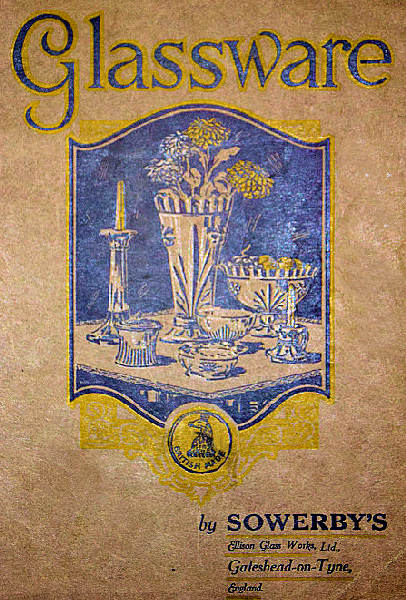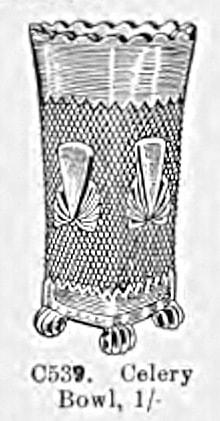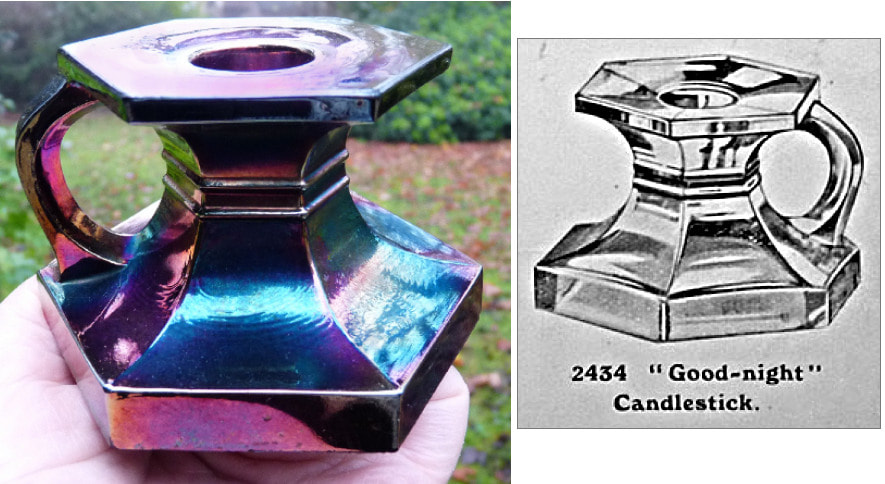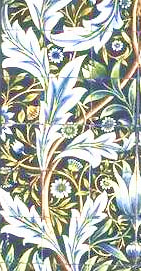NetworK ezine Issue 88. September 2022
Totally Devoted to Carnival Glass
|
Welcome to our September 2022 Issue of NetworK. This Issue is being sent out to our highest number of readers yet (and many more read it later, here on the "Back Issues" page on our website)! In this Issue we start with shining the light on Sowerby Glass. Before we proceed, it is worth saying that Sowerby's Carnival Glass has a relevance and significance to Carnival collectors all around the world ... because this English glassmaker was also a great exporter of glass, worldwide! Some of the rarer pieces of Sowerby's Carnival have been found in places that are very far away from where they were made in England. A lot has been written about Sowerby (much of it by ourselves!) but we’d like to take a fresh, unpretentious and realistic look at the factory. When did they make Carnival and what sort of was it? Sowerby Drape vases in black amethyst Carnival,
with incurved and flared out tops |
Above: the cover of the Sowerby 1927 Illustrated Pattern Book and Price List, courtesy of Mike Tomlin. The item on the bottom right is the “Good-night” candlestick (it is shown later on this page).
|
|
Let’s dig into the back-story of this fascinating glassworks, using some fresh insights and new information. Sowerby’s began making glass in the north-east of England (Tyneside) back in the early 1800s, producing some magnificent examples of pressed ware, and featuring designs that have become iconic in the world of glass collecting. In the same way that Northwood’s output was “driven” by the business acumen and artistic skills of Harry Northwood, Sowerby’s was “driven” by John George Sowerby, who is credited with designing many of their moulds. Although he had passed away just before Carnival came on the scene at Sowerby’s, his legacy lived on in the quintessential designs such as Diving Dolphins and Royal Swans (shown, right), the moulds for which were originally made and used in the 1880s, and then later revived for use in Carnival in the 1920s. John Sowerby’s design … can you decide which one? Image courtesy of Mike Tomlin.
This hand-drawn sketch for a glass item is shown in John G Sowerby’s Sketch book, initialled and dated 1900. The shape appears to be a vase or celery, and Sowerby intended it to be made as “plain or crimped”. Does it remind you of a Carnival pattern from Sowerby? It reminds us of two! Pineapple and also Sea Thistle, both of which were introduced around 1911 (and made in Carnival about a decade after that). |
Above: a very rare Royal Swans novelty posy vase in amethyst Carnival.
Made in the 1920s using an old mould from the 1880s. Above: catalogue image of a celery in Sowerby's 2371 pattern, aka Sea Thistle or Cane and Scroll (left) and a marigold sugar. The celery shape is not yet reported in Carnival, but the Sea Thistle sugar bowl and creamer are well known in marigold.
Below: catalogue image of a ruffled dish in Sowerby's 2349 pattern, known as Pineapple and an aqua Pineapple creamer. |
|
Creamers, sugars, dishes and butters are known in Sowerby’s Pineapple design. But this cake stand, shown on the right, is the only one we have ever seen. It seems to have been shaped from the stemmed sugar bowl – the top having been flattened out and the edges gently curved up. But note the uneven nature of the hand-shaping! It’s clear that the Sea Thistle and Pineapple patterns are "kissin’ cousins", as they share many design similarities. It appears highly possible that both were developed out of John Sowerby’s original design which is shown above. However ... |
|
And now ... a revelation.
Sowerby’s did in fact make an item almost exactly identical to John G Sowerby’s original 1900 sketch – and it was exported to Australia! Here it is on the right, shown in a 1911 Foy and Gibson catalogue in Sydney, Australia, as a "celery bowl". As you can see, this is the pattern we know as Pineapple, or Sowerby's number 2349. To the best of our knowledge, this celery shape is not shown in any of the Sowerby catalogues we have access to or have studied. It would appear that the Pineapple celery was only made for export – as the Australian Foy and Gibson catalogue shows. We are not yet aware of this shape in Carnival, but we can always hope. New Moulds 1922 saw the introduction of Carnival Glass at Sowerby’s. They often used pre-existing moulds, but toward the end of the decade, some fascinating new moulds were introduced too. Shapes were mainly practical, with a bias toward tableware such as creamers, sugars and butters. Vases were made too, but novelties, such as the Diving Dolphins and Royal Swans (both made using moulds from the 1880s) are scarcer, much-prized finds. The Sowerby Drape Vase (number 2437) was advertised as “New for 1927”, and we were delighted to discover that the pattern was given a name by Sowerby – it was called “Floral", as shown in the extract below from Sowerby's 1927 Pattern Book. |
The matching 2437 salad bowl has not yet been reported in Carnival, to the best of our knowledge. Three sizes of Drape / Floral vase were made, but only one (approx. 9.5 inches high) is known in Carnival. You can see it in black amethyst at the start of this ezine.
|
Above: Sowerby's "Floral".
Extract from Sowerby 1927 Pattern Book courtesy Mike Tomlin. |
Another new mould for 1927 was Sowerby’s 2434 – the “Good-night” candlestick. It was intended to be carried into the bed chamber and is only reported in black amethyst. Extract from Sowerby 1927 Pattern Book courtesy Mike Tomlin. This is a rare item indeed, perhaps it didn’t sell well at the time, or maybe examples got damaged in use by heat, or broke and were thrown away.
|
American Sets
As noted earlier, table sets were a popular item for Sowerby’s and indeed, we often see table sets from other European makers in Carnival. It’s notable that they are three-piece sets (butter sugar, creamer but no spooner) rather than the four-piece sets that the Classic Carnival makers produced.
But we discovered a fascinating fact – back in the 1880s and 1890s Sowerby’s were making what they called “American Sets” – four-piece table sets with an open spoon holder and a sugar with cover! Clearly these four-piece sets didn’t catch on in Europe, and Sowerby appear to have stopped making them, opting instead for covered butters, covered sugars and creams – omitting the spooners.
American Sets
As noted earlier, table sets were a popular item for Sowerby’s and indeed, we often see table sets from other European makers in Carnival. It’s notable that they are three-piece sets (butter sugar, creamer but no spooner) rather than the four-piece sets that the Classic Carnival makers produced.
But we discovered a fascinating fact – back in the 1880s and 1890s Sowerby’s were making what they called “American Sets” – four-piece table sets with an open spoon holder and a sugar with cover! Clearly these four-piece sets didn’t catch on in Europe, and Sowerby appear to have stopped making them, opting instead for covered butters, covered sugars and creams – omitting the spooners.
|
Insights into how Sowerby worked and traded Have you ever heard of a "hogshead"? No, not the head of a pig – this hogshead was one of the measurements of capacity used for packing – and it was how Sowerby’s offered their glassware in the 1920s when Carnival was being made. Hogsheads – effectively, a large wooden barrel. The name hogshead apparently derives from a 15th century English term 'hogges hede', which referred to a unit of liquid measurement equivalent to 63 gallons. Tierces – barrels that were a little smaller than a hogshead. They held around 30 to 40 dozen tumblers (40 dozen = 480). Casks – smallest packing unit for around 25 dozen tumblers (300). It’s interesting to note that Sowerby’s were very keen on recycling! All purchasers were refunded the full amount of the packaging costs when they returned the package (with its “head” or top intact). However, they refused cullet (broken glass), All glass was sent out at the owner’s risk. The barrels filled with Sowerby’s glass were mainly shipped out from the port of Newcastle upon Tyne, and the 1927 catalogue stated that “Coastal Steamers Sail from Newcastle Quay at regular intervals to the principal ports in the United Kingdom”. Sowerby's glass exports in the early Carnival production era were mainly to Australia, New Zealand, South Africa and South America. By 1931, India was included on the list of destinations, and shortly afterwards, Canada and Jamaica joined the list. Later, in more recent times, during a boom in the export of furniture and other antiques from the UK to the USA, we understand that drawers and other empty spaces were often filled with what were called “smalls” (smaller antiques and collectables) in the trade, and this included much Sowerby glass. We'll have more insights into Sowerby's Carnival in future issues. Interested in reading more about Sowerby's Carnival? Here are three links: Diving Dolphins Royal Swans Sowerby Special |
Above: extract from 1922 Sowerby Pattern Book, courtesy Mike Tomlin.
Sowerby used three sizes of packing: hogshead, tierce and cask. Below: The Quayside, Newcastle upon Tyne, by A E Grimshaw, 1895. Public domain, Wikimedia Commons. The High Level and Swing Bridges over the Tyne can be clearly seen. |
Quill
Dugan’s Quill is a sought-after design that was introduced by the company c. 1907 as part of their (un-iridised) “Filigree Line”. For Carnival collectors, however, it’s safe to say that the pattern had its “day in the sun” when made in purple and marigold iridised glass. It’s known only in the water set form of press moulded tumblers (below, centre) and blow-moulded pitchers (right). Note how the pitcher has extra motifs - the ovals around the top - that were omitted on the tumbler, in order to fit the design to the available space on the different shapes. The pitcher has an applied, non-iridised handle.
Dugan’s Quill is a sought-after design that was introduced by the company c. 1907 as part of their (un-iridised) “Filigree Line”. For Carnival collectors, however, it’s safe to say that the pattern had its “day in the sun” when made in purple and marigold iridised glass. It’s known only in the water set form of press moulded tumblers (below, centre) and blow-moulded pitchers (right). Note how the pitcher has extra motifs - the ovals around the top - that were omitted on the tumbler, in order to fit the design to the available space on the different shapes. The pitcher has an applied, non-iridised handle.
|
The name, “Quill” was Marion Hartung’s choice for this pattern, while Rose Presznick called it “Feather and Scroll, Embossed”. Both choices appear to assert that the dominant, recognizable motif is a feather or a quill. But is it? We don’t think it represents a feather at all. Our belief is that it actually represents the organic leaf forms that are absolutely typical of Art Nouveau |
Quill pitcher in purple, photo courtesy Seeck Auctions.
|
An interesting contemporary account of the Dugan glassworks in 1907, when Quill was introduced, was provided by the "New York Industrial Recorder" in which it was stated that the “Dugan Glass Co. was said to be the largest industry in Indiana.”
Read on …
“The Dugan Glass Co. ... (is) an immense plant, modernly equipped, covering seven acres and connected by switches with the PRR Co. and BR&P tracks. A force of 200 skilled workmen is employed. This company manufacturers the world famous Diamond "D" crystal, colored and opalescent glassware in table, lemonade and wine sets, vases, novelties, lamps, toilet bottles, etc., and originated the celebrated "Klondyke," "Louis XV," "Pagoda," "Nester," "Victor," "Venetian," "Japanese," and other equally popular lines in intaglios and filigree work. They ship all over the world and have representatives in New York, Boston, Philadelphia, St. Louis, Baltimore, Chicago, Buffalo and London, Canada, as well as in many foreign cities. Their output amounts to about $175,000 a year.”
Read the full story of Dugan’s Quill in which we show once again how Carnival Glass mirrored and reflected society’s design trends, making fashionable items affordable for ordinary people in ordinary homes. Click here: Dugan's Quill Pattern
Indiana’s Goldentone
1975-76 Florist Selection Catalogue from Indiana Glass. Courtesy Craig Schenning, the Dunkirk Museum, and the Glass Paper Fanatics.
The items shown here in Indiana's 1975-76 iridescent “Goldentone” Carnival are known by familiar names, such as Lily Pons (2876) and Sunflower (2874). The Divided Relish (2877), bottom left, is commonly known as Killarney and the large Fruit Bowl (2873) is frequently called Basketweave. The two items at the back are Pretzel (the Celery 0748) and Floral and Pineapple (the Ftd. Compote 0749). The familiar 2875 Bon Bon is often called Loganberry or Strawberry Relish. Note that some of these Indiana items date back originally to the 1930s (Killarney and Lily Pons, for example), and were re-used when Indiana started making Revival Carnival Glass.
We have a large amount of information about Indiana Revival Carnival here on our website - click here: Indiana Revival Carnival
Left: A Carnival Glass Kingfisher bowl advertised in a Nock and Kirby ad, in the Australian “Sydney Sun” newspaper, 1923, National Library of Australia.
Centre: There was more detail in this Foy and Gibson 1924 catalogue, showing item 16313 –"Aurora Glass. Fruit Salad Set, golden colour, Australian made: large bowl, measuring 8½in. across, 6 smaller bowls to match. 12/6 set." It was, of course, Crown Crystal’s Kingfisher full berry set in marigold.
Right: a Crown Crystal Kingfisher nappy (small berry) in “dark” (black amethyst) Carnival.
Centre: There was more detail in this Foy and Gibson 1924 catalogue, showing item 16313 –"Aurora Glass. Fruit Salad Set, golden colour, Australian made: large bowl, measuring 8½in. across, 6 smaller bowls to match. 12/6 set." It was, of course, Crown Crystal’s Kingfisher full berry set in marigold.
Right: a Crown Crystal Kingfisher nappy (small berry) in “dark” (black amethyst) Carnival.
For a Masterclass in Kingfisher and Kookaburra identification, authored by Peter Phillips, we have an excellent feature on our website. Peter explains, the Kingfisher and Kookaburra patterns are “probably the most confusing of our Aussie nappy bowls. So many times, the Kingfisher and Kookaburra are misidentified … and to add to the mix, there are also variants of both patterns”.
For all the answers, here’s the link: Kingfisher and Kookaburra
Privacy and the use of your information: we only use your name and email address to send you your Carnival Glass NetworK ezine. We will not share your name or email address with anyone else, or use it for any other purpose. You can change your mind about receiving your NetworK ezine at any time by clicking the unsubscribe link at the foot of every issue, or by emailing us at [email protected]
Join us on Facebook
We invite you and your friends to join us all on NetworK's fast growing and very active Facebook Group (link is below), and if you have missed any of the previous issues of NetworK and NetworK Specials, they are all here: Back Issues.
We invite you and your friends to join us all on NetworK's fast growing and very active Facebook Group (link is below), and if you have missed any of the previous issues of NetworK and NetworK Specials, they are all here: Back Issues.





















